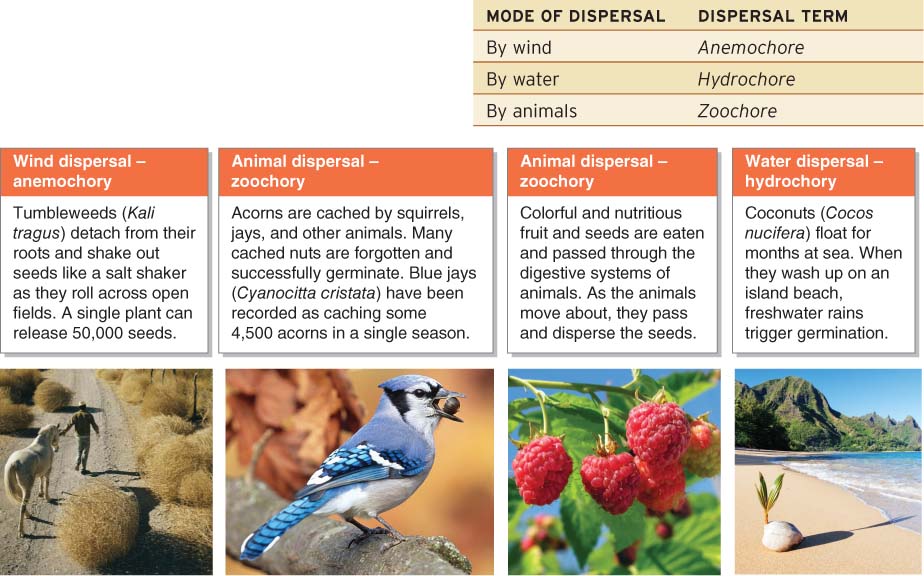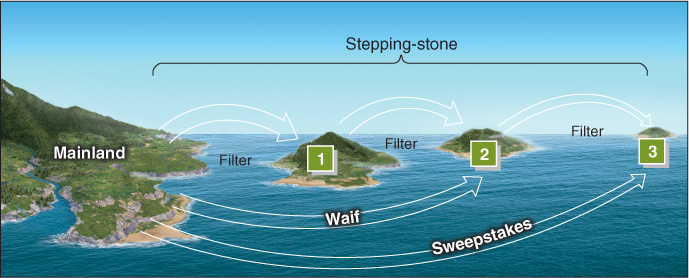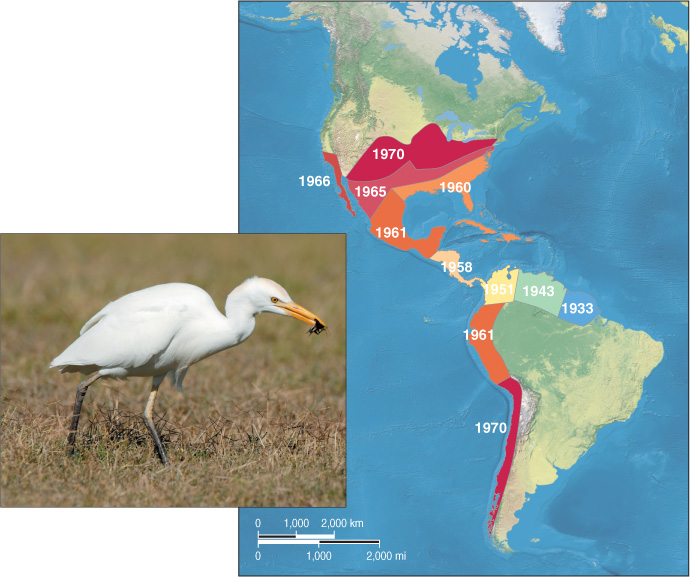7.3 Moving Around: Dispersal
Explain how organisms expand their geographic ranges.
Dispersal allows organisms to reduce competition, to obtain more resources, and to respond to environmental change. Nearly all organisms are able to disperse, some farther than others. It takes about 100 years for earthworms to disperse (unaided by people) 1 km (0.6 mi), while some birds, such as sooty shearwaters and Arctic terns (Sterna paradisaea), can fly over 500 km (300 mi) in a single day.
Intra-
Only a propagule can establish an extra-
propagule
Any material that is able to establish a new population.
Modes of dispersal can be grouped into two categories. Organisms dispersing under their own power, such as by flying, are active dispersers. Most animals are active dispersers. Organisms that move about using outside forces, such as wind or ocean currents, or by hitching a ride on other organisms are passive dispersers. Except in the rare cases in which seeds are forcefully ejected from their fruits once they dry, all plants are passive dispersers; some of their dispersal strategies are shown in Figure 7.16.

Barriers to Dispersal
There are many barriers to dispersal that affect the geographic ranges of species. A barrier to dispersal is any object or factor that restricts the dispersal of an organism. Species living on small, remote islands are surrounded by the formidable barrier of the ocean. Similarly, species living high on mountains in the Great Basin in the western United States are in virtual islands of suitable habitat that are surrounded by a barrier of inhospitable desert.
Biogeographic corridors, which allow unrestricted movement between habitats, are the opposite of barriers. The terms barrier and corridor are relative because what is an impassable barrier for one organism can be a corridor for another. For example, great white sharks (Carcharodon carcharias) frequently travel between California and Hawai‘i. Seawater is a corridor to a shark; for a freshwater fish that is intolerant of salt water, however, that seawater is an impassable barrier.
Species are found where they are as a result of many factors, among the most important of which are biogeographic filters (barriers that allow certain types of organisms to disperse across them and not others). These barriers include climatic filters, such as deserts or ice caps. Predation, competition, or a lack of mutualistic partners may act as biological filters. The oaks and pines of the Northern Hemisphere, for example, have never been able to cross the equator to the Southern Hemisphere because of the severity of the competition (a biological filter) and the warmth in the tropics (a climatic filter). Likewise, only one bear species has successfully crossed the equator. The spectacled bear (Tremarctos ornatus) inhabits forests of the Andes as far south as northern Chile. All other true bears live north of the equator.
Islands far away from the mainland can be difficult for dispersers to reach. Successful dispersal to remote islands is called waif dispersal (or accidental dispersal) because the organism that reached them was presumably lost (waif means “abandoned”) and far out of its normal range. Waif dispersal is an unlikely event with a low chance of success. Dispersal to extremely remote islands (such as the rosefinch’s dispersal to Hawai‘i; see Figure 7.6), is so unlikely that it is like winning a lottery or a sweepstakes. Such long-
sweepstakes dispersal
Dispersal across an extensive region of inhospitable space.
stepping-stone
An island in an island chain that aids in the dispersal of organisms.

Colonization and Invasion
The cattle egret (Bubulcus ibis) is found throughout much of North America, Europe, Africa, and Asia. It is a generalist and is often found feeding on insects associated with cattle. It first dispersed across the Atlantic Ocean to northern South America, perhaps as early as the 1870s. As far as is known, this bird crossed the Atlantic Ocean without the help of people. Its crossing of the Atlantic is therefore considered a natural event. The bird then quickly spread throughout the Western Hemisphere, as shown in Figure 7.18.

Most biogeographers consider the cattle egret’s dispersal across the Atlantic Ocean to be a colonization event. Colonization is the successful establishment of a population in a new geographic region without the help of people. Some biogeographers, however, think the cattle egret is an example of invasion: the successful and unwanted establishment of a species in a new geographic area as a result of human activity. They argue that the cattle egret would probably have crossed the Atlantic Ocean long ago if it were capable of doing so unaided. Instead, its crossing coincides with the increased movement of people across the Atlantic Ocean in the early 1900s, strongly suggesting that people intentionally or accidentally transported the bird across the ocean. Furthermore, its successful range expansion is made possible by the expansion of the cattle pasture habitat that the bird uses. For these reasons, they argue that the cattle egret should be considered an exotic species.
colonization
The successful establishment of a population in a new geographic region without the help of people.
invasion
The successful and unwanted establishment of a species in a new geographic area as a result of human activity.
Many organisms are dispersed around the world by people. Some are completely dependent on humans not only for their dispersal, but also for their very existence. Our food crops, such as wheat, corn, and rice, are largely or completely incapable of reproducing and dispersing without human help.  These organisms are now dispersed throughout the world. The Geographic Perspectives at the end of this chapter explores this topic further.
These organisms are now dispersed throughout the world. The Geographic Perspectives at the end of this chapter explores this topic further.